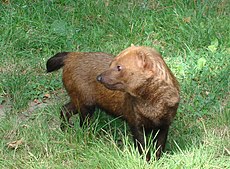덤불개속
|
| ||
|---|---|---|
 덤불개 | ||
| 생물 분류ℹ️ | ||
| 계: | 동물계 | |
| 문: | 척삭동물문 | |
| 강: | 포유강 | |
| 목: | 식육목 | |
| 과: | 개과 | |
| 속: | 덤불개속 (Speothos) Lund, 1839 | |
| 모식종 | ||
| †Speothos pacivorus | ||
| [출처 필요] | ||
학명이명 | ||
|
Icticyon Lund, 1843 | ||
| 종 | ||
| ||
덤불개속(Speothos)은중앙아메리카와 남아메리카에서 발견되는 개과 속의 하나이다.[1][2] 현존하는 유일종 덤불개와 멸종된 플라이스토세 종 플라이스토세덤불개를 포함하고 있다. 특이하게도, 살아있는 종을 발견하기 전에 화석종이 먼저 등재되어 모식종이 플라이스토세덤불개(S. pacivorus)이다.
하위 종
[편집]계통 분류
[편집]| 개과 |
| |||||||||||||||||||||||||||||||||||||||||||||||||||||||||||||||||||||||||||||||||||||||||||||||||||||||||||||||||||||||||||||||||||||||||||||||||||||||||||||||||||||||||||||||||||||||||||||||||||||||||||||||||||||||||||
각주
[편집]- ↑ Wozencraft, W.C. (2005). “GENUS Speothos”. Wilson, D.E.; Reeder, D.M. Mammal Species of the World: A Taxonomic and Geographic Reference (영어) 3판. 존스 홉킨스 대학교 출판사. 532–628쪽. ISBN 978-0-8018-8221-0. OCLC 62265494.
- ↑ Berta A., 1984. The Pleistocene Bush Dog Speothos pacivorus (Canidae) from the Lagoa Santa Caves, Brazil Journal of Mammalogy 65(4):549-559.
- ↑ Lindblad-Toh, Kerstin; Wade, Claire M; Mikkelsen, Tarjei S.; Karlsson, Elinor K.; Jaffe, David B.; Kamal, Michael; Clamp, Michele; Chang, Jean L.; Kulbokas, Edward J.; Zody, Michael C.; Mauceli, Evan; Xie, Xiaohui; Breen, Matthew; Wayne, Robert K.; Ostrander, Elaine A.; Ponting, Chris P.; Galibert, Francis; Smith, Douglas R.; Dejong, Pieter J.; Kirkness, Ewen; Alvarez, Pablo; Biagi, Tara; Brockman, William; Butler, Jonathan; Chin, Chee-Wye; Cook, April; Cuff, James; Daly, Mark J.; Decaprio, David; 외. (2005). “Genome sequence, comparative analysis and haplotype structure of the domestic dog”. 《Nature》 438 (7069): 803 in 803–19. doi:10.1038/nature04338. PMID 16341006.
- ↑ Nyakatura, K.; 외. (2012). “Updating the evolutionary history of Carnivora (Mammalia): a new species-level supertree complete with divergence time estimates”. 《BMC Biology》 10 (12). doi:10.1186/1741-7007-10-12.
- ↑ Koepfli, Klaus-Peter; Pollinger, John; Godinho, Raquel; Robinson, Jacqueline; Lea, Amanda; Hendricks, Sarah; Schweizer, Rena M.; Thalmann, Olaf; Silva, Pedro; Fan, Zhenxin; Yurchenko, Andrey A.; Dobrynin, Pavel; Makunin, Alexey; Cahill, James A.; Shapiro, Beth; Álvares, Francisco; Brito, José C.; Geffen, Eli; Leonard, Jennifer A.; Helgen, Kristofer M.; Johnson, Warren E.; o'Brien, Stephen J.; Van Valkenburgh, Blaire; Wayne, Robert K. (2015). “Genome-wide Evidence Reveals that African and Eurasian Golden Jackals Are Distinct Species”. 《Current Biology》 25 (16): 2158–65. doi:10.1016/j.cub.2015.06.060. PMID 26234211.
